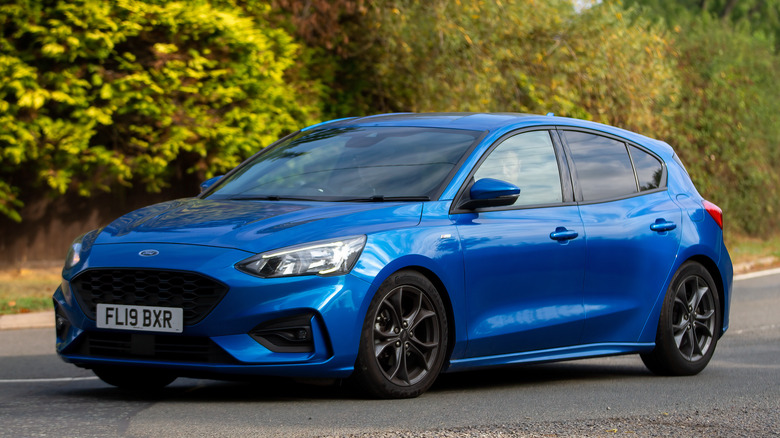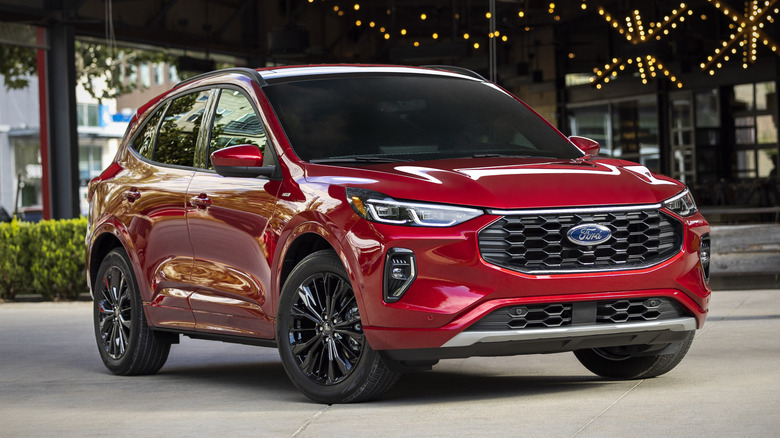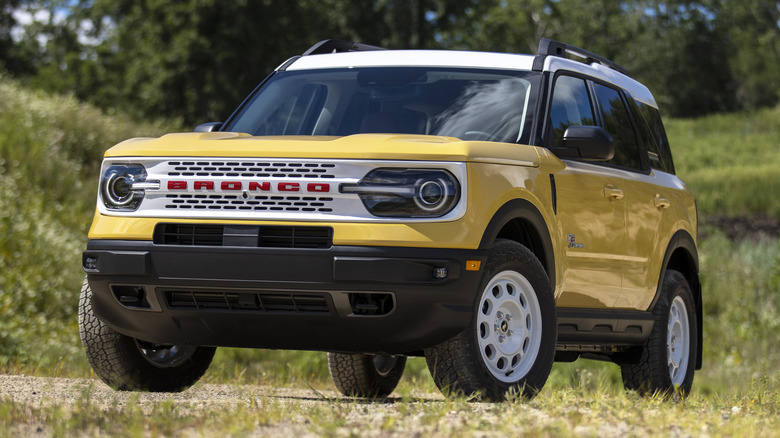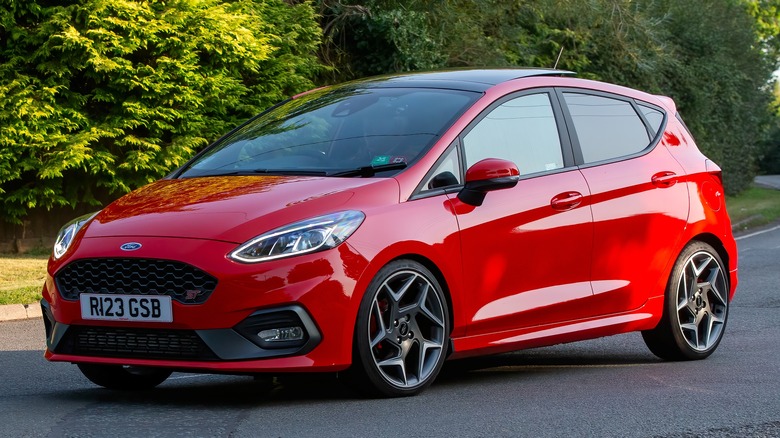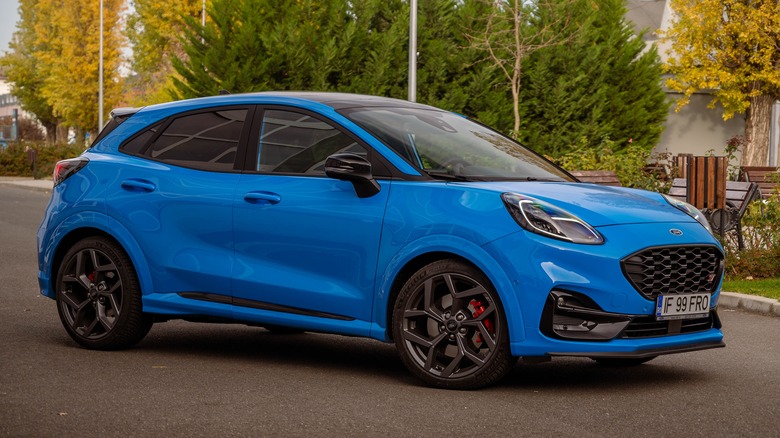Every Ford Powered By The 1.5L EcoBoost 'Dragon'
With the EV revolution seemingly slowing down, it's a good time to remember that, despite their polluting nature, there's still a lot of life left in the good old internal combustion engine. Case in point, Ford's EcoBoost engines, which retain the feel — and relative convenience — of gas-powered-engines while keeping emissions down and achieving great mileage.
It all started with a 3.5-liter, twin-turbo V6 that debuted in the 2009 Lincoln MKS. The V6 made 355 hp and 350 lb-ft of torque but still managed a respectable 25 mpg on the highway, offering significantly more power than Ford's old 274-hp V6 without impacting fuel economy at all. Ford knew it was on to something good, and would eventually introduce a range of four-cylinder EcoBoost engines to the family, culminating in the mid-2010s 1.5-liter inline-four EcoBoost that powered cars like the second-generation Ford Fusion.
The 1.5-liter four-cylinder's time in the sun was quite short though, and the company debuted the 1.5-liter EcoBoost Dragon in 2017. The Dragon wasn't a variation of the inline-four, despite the identical displacement. It was an upsized version of the three-cylinder 1.0-liter Fox, with features such as cylinder deactivation and a combination of direct and port fuel injection to boost fuel economy. The Dragon started replacing the 1.5-liter inline-four in Ford cars soon after its debut, and carries on in a handful of models today — here's a look at all of them, past and present.
Ford Focus (2018 - 2022)
Ford's much-loved and soon-to-be-discontinued Focus was one of the earliest Ford cars to get a 1.5-liter EcoBoost engine, in the form of the 1.5-liter inline-four EcoBoost that debuted as an engine option starting in 2014. The four-pot motor had a long run in the European-market Focus, eventually replacing the old 1.6-liter Duratec engine in its higher trim levels — Titanium, Titanium X, and ST-Line — starting in 2017. However, the 1.5-liter EcoBoost's reign at the top of the Focus' non-ST engine options only lasted a few more years after that.
Ford introduced the three-cylinder 1.5-liter EcoBoost Dragon to the European Focus starting in 2018, and buyers could choose between either 148- or 180-hp versions. The former was available with a six-speed manual or eight-speed automatic, while the latter option was only available with a six-speed.
Ford kept the Dragon engine in the European-market Focus without any significant changes until the 2021 model year. The new decade kicked off with Ford dropping the 1.5-liter engine entirely; in its place were a couple of mild-hybrid versions of the 1.0-liter EcoBoost engine, which will likely be the engine setup in the car until Ford discontinues the Focus in 2025.
But that's just the European Focus; things played out differently in other regions. Ford offered the Dragon for an extra year in Australia, and it lasted even longer yet in China. The Chinese Focus rocked the Dragon into 2022 before Ford went back to a four-cylinder EcoBoost for 2023.
Ford Escape and Kuga (2020 - present)
The Ford Escape and Ford Kuga have gone hand-in-hand since 2012, when Ford's One Ford initiative led it to market the same SUV under different names in North America — Escape — and Europe — Kuga. As such, the two models share a lot in common, not least the 1.5-liter EcoBoost Dragon present under the hood.
Ford unveiled the fourth-generation 2020 Escape at the 2019 New York Auto Show with an all-new design echoing the contemporary European Ford Focus. The 2020 Escape would be the marque's entry-level model in the U.S., fitting in where cars like the Focus and Fiesta — both of which Ford had recently dropped — had once existed.
However, the styling wasn't the only new thing: Out went the old four-cylinder 1.5-liter EcoBoost of the previous-generation Escape, and in its place was the three-cylinder Dragon with 181 hp and 190 lb-ft of torque. Other engine options included a 2.0-liter EcoBoost and a couple of 2.5-liter hybrid engines. The 2020 Kuga received the same three-cylinder EcoBoost engine, although European buyers had much less power to play with. The Kuga's Dragon maxed out at 148 hp, with the base Zetec model also available with a lower-powered 118-hp version.
Both the Escape and Kuga are still available with the 1.5-liter EcoBoost Dragon in 2024, although Ford dropped the Kuga's 118-hp option after a mid-cycle refresh in 2024.
Ford Bronco Sport (2021 - present)
A Bronco with a three-cylinder engine may sound a bit strange, but the Bronco Sport isn't quite the off-road-ready truck that the full-fat Ford Bronco is. Instead, the Bronco Sport is, to quote our own first look at the 2025 Bronco Sport, something of a soft-roader. It's an off-road capable SUV, sure, but it shares more with the Ford Escape than its Bronco namesake. So while it's not a total fish out of water in the dirt, it's probably not quite one for the hardcore overlander, either.
Despite being more of an Escape in Bronco clothing than a full-fledged Bronco, Ford took a page out of the latter's playbook and launched the Bronco Sport with four trim levels — Base, Big Bend, Outer Banks, and Badlands. The first three options offered the 1.5-liter Dragon in 181-hp, 190 lb-ft guise as standard, while Badlands variant moved up to the 250-hp, 2.0-liter EcoBoost. The Dragon-equipped Bronco Sports cam with a conventional eight-speed automatic and access to five G.O.A.T. — Goes Over Any type of Terrain — modes, compared to the paddle-shift auto and seven G.O.A.T. modes on the 2.0-liter Bronco Sport Badlands.
Ford's updated the Bronco Sport's trim levels over the years — introducing a pricey Heritage edition to match the $70,000 Ford Bronco Heritage Edition in 2024 — but has kept the SUV's engine options the same throughout. The 181-hp, 1.5-liter Dragon is still available in the 2025 Bronco Sport.
Ford Fiesta ST (2018 - 2023)
Despite making its way to a couple of North American Fords, the Dragon has always been more commonplace in European offerings like the Ford Fiesta ST. Ford introduced the eighth-generation Fiesta ST in 2018, following the base Fiesta's debut a year earlier. But where the base Fiesta maxed out at 138 hp from the 1.0-liter Fox, the ST packed the 1.5-liter Dragon under the hood.
This wasn't just any old 1.5-liter Dragon, though. The Fiesta ST's version packed a fire-breathing 197 hp and 214 lb-ft of torque. This was enough to take the hot hatch to 62 mph in 6.5 seconds; not supercar numbers, admittedly, but very quick for a practical, three-cylinder hatchback — and good enough to help the Fiesta ST earn Top Gear's Car of the Year award in 2018. The magazine's Chris Harris liked it enough to claim that the 2018 Fiesta ST may have been the best small hatchback ever built; high praise indeed.
Ford initially offered the Fiesta ST in three trim levels — the imaginatively named ST-1, ST-2, and ST-3 — with increasing levels of electronic aids and creature comforts, although all had the same engine. 2022 saw the debut of a facelifted Fiesta and Fiesta ST with updated styling and electronics, and the removal of the basic ST-1 trim. But this facelifted Fiesta didn't last long: Ford discontinued the Fiesta just a year later, with the final unit rolling off of the production line in July 2023.
Ford Puma ST (2021 - present)
The Fiesta ST may no longer be with us, but that doesn't mean Ford has deprived fans of the Dragon's most powerful form — at least, in Europe.
Ford debuted the Puma crossover in 2019 for the 2020 model year, basing it on the soon-to-be-discontinued Fiesta. Unlike the Fiesta, though, Ford went down the hybrid route for the Puma, launching it with two mild-hybrid versions of the 1.0 EcoBoost. But while the engines may have differed, one thing was the same: Ford wasn't content just making an eco-friendly version of the Puma. Enter the Ford Puma ST, which debuted in 2021.
The Puma ST launched with a 197-hp EcoBoost Dragon and six-speed manual, good enough for a zero to 62 mph time of 6.7 seconds. It's not as fast as pricier rivals like the Volkswagen T-Roc R, which hits 62 mph in just 4.9 seconds — but straight-line speed isn't everything. Reviewers have praised the Puma ST's handling, with some hailing it as the best-driving car in its class.
Ford introduced the Puma ST Powershift in 2023, which has mild hybrid 1.0-liter EcoBoost and seven-speed automatic. Ford continues to promote both STs, but it seems that the Powershift is going to be the only ST available going forward — although there's no official word from Ford yet. If you're reading this and want to get a 200-hp version of one of Ford's best-looking SUVs ever, you'd better buy one quick.
Ford Fiesta Rally3 (2021 - present)
And now for something different. Unlike many of the larger-displacement EcoBoost engines in Ford's stable — and like its 1.0-liter sibling, the Fox — the Dragon hasn't just featured in the engine bays of mass-produced consumer vehicles. The Dragon also has some racing pedigree, powering the M-Sport Poland-built Ford Fiesta Rally3 car that debuted in 2021.
Of course, the Rally3 doesn't have a stock Dragon engine. As impressive as 181 hp from a 1.5-liter three-cylinder is, that's still not quite enough for serious rally racing. So, M-Sport's engine builders strip each Dragon down to the block and upgraded them with higher-quality forged internals and a bigger turbo. The result is 215 hp and 295 lb-ft of torque. Mated to a sequential five-speed manual transmission, the Rally3 hits 62 mph in 5 seconds before topping out at 115 mph. That's nowhere near the fastest rally cars ever, but it's not bad for what would normally be an eco-friendly three-cylinder.
The Rally3 is one of a handful of EcoBoost-powered, Fiesta-based rally cars that M-Sport builds, the others being the Fiesta Rally2 — which succeeded the Rally5 and has a 1.6-liter EcoBoost under the hood — and 1.0-liter Rally4. As of 2024, the Fiesta Rally3 is the car of choice in the FIA's Junior World Rally Championship and the ERC Fiesta Rally3 Trophy, both of which take place across Europe. And, yes, M-Sport still builds Fiestas, even though Ford itself has discontinued the model.
[Image by Miloslav Rejha via Wikimedia Commons | Cropped and scaled | CC BY 4.0]

